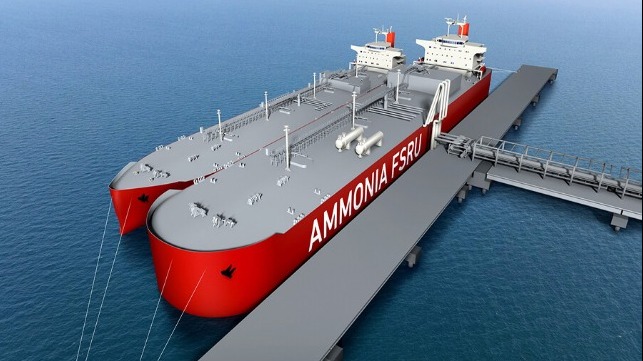Japanese Study Using FSRUs to Support Wider Adoption of Ammonia

In an effort to speed the adoption and lower the cost of ammonia as an alternative fuel, Japan’s Mitsubishi Shipbuilding and Mitsui O.S.K. lines are studying the possibility of adopting the successful FSRU concept for the use of ammonia. The floating storage and regasification technology is being increasingly used to support the growth of LNG and now the Japanese companies are exploring using their experience in the sector to support the expected rapid growth in ammonia as a carbon-free fuel.
The companies pointed out that currently the maritime transport volume of ammonia is limited mainly to the use as a raw material for fertilizer. The properties of the gas require special handling and unique facilities. Just as the FSRU is being used as floating facilities that receive LNG offshore for storage, regasify it onboard, and send it ashore they believe the same approach could be used to speed the adoption of ammonia.
According to the partners, employing FSRUs offers the advantage of shorter construction time and lower costs in comparison to the construction of onshore storage tanks and regasification plants. In addition to reducing the time required for adoption, they believe the FSRUs would contribute to the wider use of the next-generation fuel.
Together Mitsui and Mitsubishi have completed a conceptual study exploring multiple case studies for the use of FSRUs. They explored different specifications according to the ammonia's supply conditions, regasification method, and tank capacity to respond to a wide range of demands, and eventually developed designs of more environmentally friendly ammonia FSRU. The study also covered the feasibility of employing ammonia fuel to generate the power required for the operation of the FSRU.
The team developed a design concept of a lower environmental impact FSRU that would be powered by electricity generated with ammonia fuel.
As the next step in their goal to deploy the world’s first ammonia FSRU, Mitsubishi Shipbuilding, MOL and The Kansai Electric Power Co. concluded a memorandum of understanding and are conducting a study exploring the opportunities for introducing ammonia FSRUs in various regions of the world.
Both Mitsubishi Shipbuilding and MOL have been pursuing a range of projects linked to ammonia. Together with Namura Shipbuilding, they announced a project last year to introduce the first large ammonia-fueled ammonia carriers by 2026. MOL is also part of a project their received design approvals for an ammonia bunkering vessel while Mitsubishi has also been participating in industry projects to support the safe use of ammonia as a shipping fuel.
